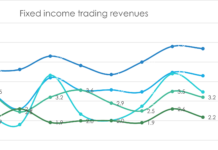A report by consultancy GreySpark has found that in 2020, global fixed income e-trading landscape has been defined by fragmentation in line with historical changes first observed by the firm in 2013.
The findings, in a report authored by management consultants including Russell Dinnage, part of the firm’s capital markets intelligence practice, found fragmentation is characterised by a growing number of bonds and swaps trading venues that are altering or launching brokerage business models focused on all-to-all (A2A), multi-polar trading protocols that are – in large part – driven by increasing competitive structures for order and trade execution pricing.
A key characteristic in the growth of the corporate bonds market’s electronic sophistication could be an increase in the provision of emerging markets (EM) issuances and derivatives products across a wider number of incumbent and new nonbank brokerage venues. For example, venue operators Liquidnet and Trumid added EM investment grade and high-yield fixed income securities onto their platforms in 2019 and in 2020, respectively, with Liquidnet already seeing EM bonds represent 20% of their total fixed income trading volume.
According to GreySpark, at the centre of the fixed income marketplace, Corporate & Investment Bank (CIB) broker-dealers continue to intermediate buy-side access to bonds and swaps liquidity and marketplaces, but they are no longer the sole providers of fixed income liquidity in 2020 as intermediation services are now increasingly handled by other types of financial services firms.
CIB intermediation continues to occur through established single-dealer platforms (SDPs) or via direct electronic access (DEA) via D2C venue channels whereby various liquidity providers compete to satisfy buyside client demand for liquidity access.
However, advancements in the continued evolution of CIB fixed income business and trading models across, primarily, Tier I and Tier II institutions suggest the adoption of hybrid agency-principal intermediation approaches first identified in 2014 are advancing in their complexity in an effort to offer more selective services, which is indicative of a transition of emphasis within the industry away from volumes transacted and toward value-for-money client services.
©Markets Media Europe 2025













